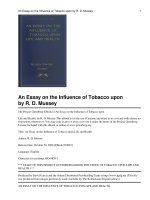Tobacco taxation purpose and myths the role of the WB
Bạn đang xem bản rút gọn của tài liệu. Xem và tải ngay bản đầy đủ của tài liệu tại đây (1.71 MB, 64 trang )
Tobacco taxation:
Purpose and Myths.
The Role of the WB
Montserrat Meiro-Lorenzo
The World Bank,
Outline
• Why?
• What to do? Clear
• How to do it? Article 6
• Key issues
• The Word Bank
Four Stages of Tobacco Smoking Epidemic
Source: Lopez AD, Collishaw NE, Piha T. A descriptive model of the cigarette epidemic in developed countries.
Tobacco Control, 1994; 3: 242-247.
Why tax tobacco? Economist
"Sugar, rum, and tobacco, are commodities
which are no where necessaries of life, which are
become objects of almost universal
consumption, and which are therefore extremely
proper subjects of taxation.
Adam Smith, An Inquiry into the Nature and Causes of The
Wealth of Nations, 1776
Why
Tax
Tobacco?
•Economic Efficiency
• Correct for failures in tobacco product markets
• Imperfect information
• Externalities
• Increased health care costs, lost productivity
• Increased financial costs related to publicly
financed health care used to treat diseases
• Can also include “internalities” that result from
addiction and time inconsistent preferences
•Other Motives affecting tax structure:
• To protect domestic industry and employment
• To keep some brands/products affordable to the
poor
Chalupka 2012
5
Why Tax tobacco? Health
Because high tobacco prices CAN:
•Reduce the % of people that use
tobacco products (prevalence).
•Reduce the quantity consumed by
those that continue to smoke
Improve health outcomes
6
Taxes, Prices; Health: US,
1980-2005
7
People Respond to Prices
• 10% price increase
price change
developing
countries
+10%
developed
countries
-8%
-4%
consumption change
reduces tobacco use rates
by about 4% among the
poor and around 8%
among the better off.
• Price-elasticity of demand
for cigarettes in LICs and
MIC is around -0.6
• Poor and young respond
more to prices than the
better-off and old
Source: MTF, Tax Burden on Tobacco, 2011, and author’s calculations
9
Taxes, Prices and Tobacco Use
Cig are tte Co ns umptio n, Mo ro c c o , 1965-2000
Source: Aloui, 2003
10
Cigarette consumption in SA, 1946 - 2011
11
A very close relationship between cigarette
consumption and affordability (r = - 0.98)
12
Cigarette Taxes and Prices Globally
13
Average Price Most Sold Brand, Excise Tax/Pack &
Total Share 2010
Source: WHO GTCR III
Tobacco Tax: Time to Abolish Myths
• Will reduce government revenues.
• Will destroy jobs / hurt particularly farmers
• Smuggling (Illicit trade)
• Difficult to collect and implement
• Regressive (against poor)
• WTO, investment bilateral, agreements
Will reduce government
revenues
Philippines losses
The South African experience,
1961 - 2011
Big increases in the excise tax have resulted in big increases in tax
revenue
Between
1993 and
2011 real
excise tax
increases by
487% and
real excise tax
revenue
increases by
249%
18
Fall in consumption, real excise &
industry revenues increased
19
Percentage changes in important
variables since 1993
Variable
Percentage
Real excise tax per pack of cigarettes
378%
Real net-of-tax price of cigarettes
153%
Real retail price
212%
Cigarette consumption
-33%
Per capita cigarette consumption
-51%
Real excise tax revenue
220%
Real industry revenue
69%
Smoking prevalence
From about 35% to about 22%
20
Destroy jobs, hurt farmers
•Tobacco Leaf production
Global : 6 million tons
Zimbabwe: 0.21 Tons (3.5%)
Malawi: 0.13 (2.2 %)
Where are the subsidies going?
Brazil COP4: Farmers demonstrations
Will destroy jobs, will hurt farmers
• Indian and Brazil experience from tobacco
farmers and bidi roller's opposition to tough
demand reduction measures on WHO-FCTC
• Min of Agriculture initiative engagement with
MOH and advocacy to farmers e.g. bamboo as
source of energy nets 3000 USD per acre as
against 1000 USD rom tobacco
• Min of Labour and Min of Rural Development
schemes on alternative livelihood to farmers
and bidi rollers
WILL INCREASE
SMUGLING &
ILLICIT TRADE
23
Mechanisms for Illicit trade
control
•Who? Who are the manufacturers
•What? What are they
manufacturing ciagrrets, chewing
and wich tarde marks
•How much? Manufacturing
production
•For whom? destination of products
24
Smuggling tobacco UK 1990s
Tobacco industry
25-30%
UK customs estimated
21%
Taxed cigarettes/lower tax coun.: 9%
Illicit hand rolled tobacco:
49%
Main drivers – lack of control of
international movement of tax free
tobacco, price difference between tax









